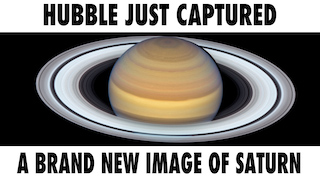Colossal Glow
Scientists first observed Saturn’s auroras in 1979. Decades later, these shimmering ribbons of light still fascinate. For one thing they’re magnificently tall, rising hundreds of miles above the planet’s poles. And unlike on Earth where bright displays fizzle after only a few hours, auroras on Saturn can shine for days. Auroras are produced when speeding particles accelerated by the sun’s energy collide with gases in a planet’s atmosphere. The gases fluoresce, emitting flashes of light at different wavelengths. Watch the video to see an edge-on view of Saturn’s northern and southern lights courtesy of NASA’s Hubble Space Telescope.

Saturn’s auroras put on a dazzling display of light.
Saturn’s auroras dance in sync in this time-lapse video assembled from ultraviolet images taken by Hubble.

Radiant bands form rings above Saturn's southern polar region in this false-color image.

Hubble took these images of Saturn’s auroras over a period of five days.

Auroras are colored green in these infrared views of Saturn.
Credits
Please give credit for this item to:
NASA's Goddard Space Flight Center
Cover image courtesy of NASA/ESA/STScI/A. Schaller
Video courtesy of NASA/ESA/University of Leicester/J. Nichols
False-color image courtesy of NASA/JPL/University of Colorado
Hubble image courtesy of NASA/ESA/J. Clarke, Boston University/Z. Levay, STScI
Infrared image courtesy of NASA/JPL/University of Arizona/University of Leicester
-
Writer
- Paul Gabrielsen (NASA/GSFC)
Release date
This page was originally published on Thursday, October 24, 2013.
This page was last updated on Wednesday, May 3, 2023 at 1:51 PM EDT.
